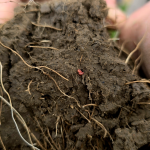Trust submits on soil carbon sequestration
HB Future Farming Trust made a submission to MPI and MfE on their consultation on the future Emissions Trading Scheme. We focused entirely on awarding farmers credit for soil carbon sequestration.
Added 3 years ago

HB Future Farming Trust made a submission to MPI and MfE on their consultation regarding agriculture’s treatment in the future Emissions Trading Scheme. We focused entirely on the case for awarding farmers credit for soil carbon sequestration.
Here are our key comments.
Hawkes Bay Future Farming Trust strongly advocate that soil carbon be included in the future Emissions Trading Scheme (ETS).
Work the Trust has undertaken demonstrates … that adequately funded science can underwrite soil carbon as a viable offset to farmers and allow opportunities to offset other on-farm emissions.
At the same time incentivising farmers to look for ways to permanently sequester soil carbon has positive flow-on to retaining more soil moisture and nutrients and promotes a more diverse biosystem.
Hawke’s Bay Future Farming Trust has been working with farmers to test whether carbon can actually be ‘grown’ in the soil and used to offset harmful climate-warming emissions. Our strong evidence shows it can. (Note: see this video describing the soil carbon measurement work the Trust undertook.)
One example is a dairying operation in Hawke’s Bay farming on three farms totalling over 1,000 hectares. Farm 1 has been farmed regeneratively since 2007, Farm 2 since 2016 and Farm 3 since 2019. The farms are in close proximity and share soils, geology and climate. They also shared a prior history of intensive farming employing chemical ‘best practice’ as prescribed by conventional agribusiness.
Regenerative practices have added to soil carbon stocks, improving water infiltration and retention, and are yielding more profitable farming. The differences in the soil health, pasture quality and pasture root length and density on the three farms was tested to see if those differences could correspond to differences in the soil carbon levels.
Under ‘regenerative’ management for at least the last 10 years, 5 years, and 12 months respectively, significant differences in soil carbon and nitrogen were detected.
The general consensus has been that NZ’s soil carbon levels are high and therefore we won’t be able to improve them; these results challenge that thinking.
In addition, no synthetic fertilisers or chemicals that can compromise microbial life or animal health were used. Organically approved fertiliser was applied to achieve mineral balance and stimulate microbial life.
Principles applied:
- Encourage pasture diversity: Every plant species uniquely adds to the complexity and proliferation of soil microbial life (i.e. soil health)… the same way eating a diversity of healthy whole foods forms the basis of a functioning human microbiome to promote good health and vitality.
- Intensive grazing with ruminant animals: High stock density with frequent shifting and long pasture recovery time. This replicates the deep soil building processes of the North American bison herds and wildebeest herds of Africa (kept compact by predators) that grazed, trampled, defecated, urinated and salivated their way across abundant grasslands adding fertility, composting in situ, re-inoculating and stimulating soil microbiology as they went. Fenced paddocks with water supply replace the predator effect in the NZ pastoral setting.
- All grass farming with minimal soil disturbance: This reduces soil loss through wind and rain and encourages mycorrhizal fungi growth – filaments that bridge soil microbes to plants, creating a resource trading ‘internet’. The plant offers photosynthetically derived sugars (from atmospheric carbon) in exchange for essential minerals delivered by the soil’s wide fungal network.
The result of these practices is in situ composting and carbon trading, sequestering carbon deep in the soil as stable humus … the essence of live healthy soil. Bigger differences in soil carbon were also found between the farms at greater depth than expected.
Even a small portion of change over NZ’s pastureland would have a huge impact on our GHG profile.
The great advantage with soil carbon, compared to forestry, is that you can claim the GHG benefit, keep the carbon in the ground where it improves the water holding and nutrient holding ability of the soil, and keep growing low GHG food on the land.
This study offers very positive news for pastoral farmers. The benchmarking shows that significant differences in soil C can be grown in NZ soils under pastoral farming management.
There is a strong indication from our historic soil quality monitoring that managing pastures using regenerative farming methods can result in soil carbon sequestration and Nitrogen attenuation at rates that are highly significant from an environmental management viewpoint.
The ETS should have soil carbon included to incentivise NZ pastoral farmers to integrate land management practices over time that encourages soil carbon sequestration as a viable offset in the ETS.
Our full submission can be read here.
Join the conversation
Chris Thorman - Nov 29, 2022, 10:38 AM
I am leading a project to Gamma ray scan soils.
we now have some results and are happy to share those with you. We can scan and map carbon, but we still have some work to do on the results.
GRS allows us to take 800 plus full soil samples per ha giving significantly improved data to manage all aspects of soils, with over 30 different soil parameters mapped.
Chris Thorman - Nov 29, 2022, 10:38 AM
I am leading a project to Gamma ray scan soils.
we now have some results and are happy to share those with you. We can scan and map carbon, but we still have some work to do on the results.
GRS allows us to take 800 plus full soil samples per ha giving significantly improved data to manage all aspects of soils, with over 30 different soil parameters mapped.
Leave a comment
All comments are reviewed before they are published on the website. Your email address will not be published.



Community Engagement and Knowledge Sharing Strengthen the Carbon Positive Project


Farewell to Trustee Phil Schofield – A Foundational Leader of the HBFFCT

